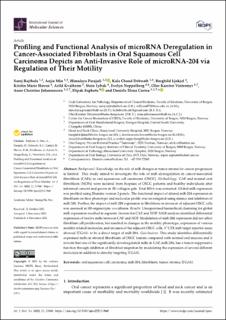| dc.contributor.author | Rajthala, Saroj | |
| dc.contributor.author | Min, Anjie | |
| dc.contributor.author | Parajuli, Himalaya | |
| dc.contributor.author | Debnath, Kala Chand | |
| dc.contributor.author | Ljøkjel, Borghild | |
| dc.contributor.author | Hoven, Kristin Marie | |
| dc.contributor.author | Kvalheim, Arild | |
| dc.contributor.author | Lybak, Stein | |
| dc.contributor.author | Neppelberg, Evelyn | |
| dc.contributor.author | Vintermyr, Olav Karsten | |
| dc.contributor.author | Johannessen, Anne Christine | |
| dc.contributor.author | Sapkota, Dipak | |
| dc.contributor.author | Costea, Daniela Elena | |
| dc.date.accessioned | 2021-11-29T08:05:02Z | |
| dc.date.available | 2021-11-29T08:05:02Z | |
| dc.date.created | 2021-11-15T15:06:12Z | |
| dc.date.issued | 2021-11-04 | |
| dc.identifier.issn | 1422-0067 | |
| dc.identifier.uri | https://hdl.handle.net/11250/2831794 | |
| dc.description.abstract | Background: Knowledge on the role of miR changes in tumor stroma for cancer progression is limited. This study aimed to investigate the role of miR dysregulation in cancer-associated fibroblasts (CAFs) in oral squamous cell carcinoma (OSCC). Methodology: CAF and normal oral fibroblasts (NOFs) were isolated from biopsies of OSCC patients and healthy individuals after informed consent and grown in 3D collagen gels. Total RNA was extracted. Global miR expression was profiled using Illumina version 2 panels. The functional impact of altered miR-204 expression in fibroblasts on their phenotype and molecular profile was investigated using mimics and inhibitors of miR-204. Further, the impact of miR-204 expression in fibroblasts on invasion of adjacent OSCC cells was assessed in 3D-organotypic co-cultures. Results: Unsupervised hierarchical clustering for global miR expression resulted in separate clusters for CAF and NOF. SAM analysis identified differential expression of twelve miRs between CAF and NOF. Modulation of miR-204 expression did not affect fibroblast cell proliferation, but resulted in changes in the motility phenotype, expression of various motility-related molecules, and invasion of the adjacent OSCC cells. 3′ UTR miR target reporter assay showed ITGA11 to be a direct target of miR-204. Conclusions: This study identifies differentially expressed miRs in stromal fibroblasts of OSCC lesions compared with normal oral mucosa and it reveals that one of the significantly downregulated miRs in CAF, miR-204, has a tumor-suppressive function through inhibition of fibroblast migration by modulating the expression of several different molecules in addition to directly targeting ITGA11. | en_US |
| dc.language.iso | eng | en_US |
| dc.publisher | MDPI | en_US |
| dc.rights | Navngivelse 4.0 Internasjonal | * |
| dc.rights.uri | http://creativecommons.org/licenses/by/4.0/deed.no | * |
| dc.title | Profiling and functional analysis of microRNA deregulation in cancer-associated fibroblasts in oral squamous cell carcinoma depicts an anti-invasive role of microRNA-204 via regulation of their motility | en_US |
| dc.type | Journal article | en_US |
| dc.type | Peer reviewed | en_US |
| dc.description.version | publishedVersion | en_US |
| dc.rights.holder | Copyright 2021 the authors | en_US |
| dc.source.articlenumber | 11960 | en_US |
| cristin.ispublished | true | |
| cristin.fulltext | original | |
| cristin.qualitycode | 1 | |
| dc.identifier.doi | 10.3390/ijms222111960 | |
| dc.identifier.cristin | 1954768 | |
| dc.source.journal | International Journal of Molecular Sciences | en_US |
| dc.identifier.citation | International Journal of Molecular Sciences. 2021, 22 (21), 11960. | en_US |
| dc.source.volume | 22 | en_US |
| dc.source.issue | 21 | en_US |

